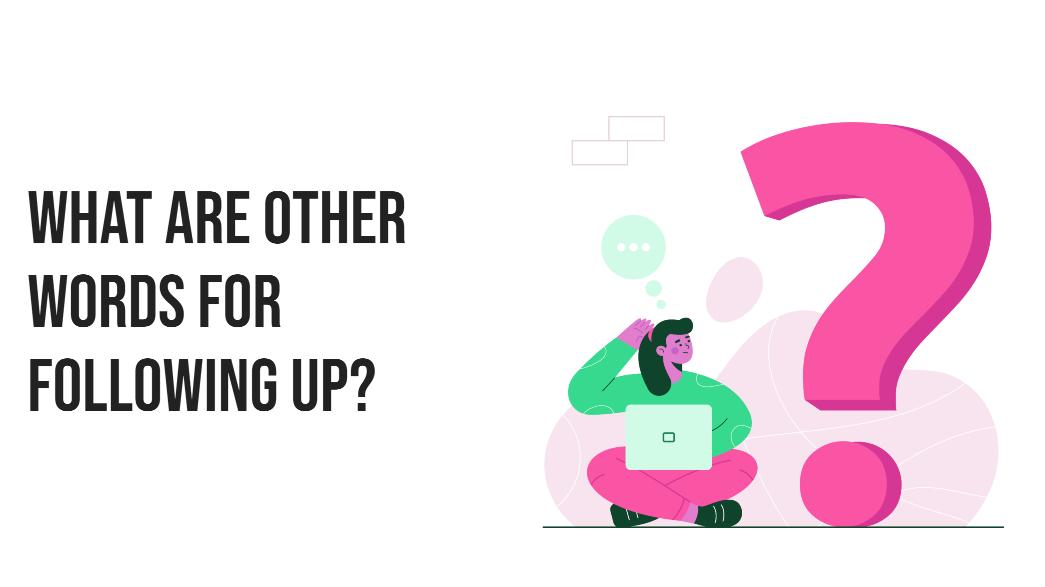
What are Other Words for Following Up?
Don't always term a follow-up as a follow-up!
Email Marketing
Don't always term a follow-up as a follow-up!
Published:
Email Marketing
Wajeeha Gull
Share

Email marketers know how important it is to follow up on a lead. To leave your customer without further action is a rookie mistake. Safe to say, the artful follow-up is an interesting process, one you should implement meticulously.
Businesses have to keep reminding potential clients why their brand matters by creating a follow up message with particular words that carry hefty meaning. Verily, the success of your efforts is directly tied to the effectiveness of your follow-up strategy.
Before we continue to dive deep into the topic, let's count the number of times we've used - or overused - the word 'follow up' already. 5 times in a total of 115 words up until the last sentence.
At this pace, you'll be chanting the two words in your sleep. And as much as the next-door marketer would love that, it doesn't hurt to use follow-up synonyms from time to time.
Rather than scour through a lengthy thesaurus, we suggest you read on instead. Our list of top picks includes the most seasoned follow-up synonyms for your marketing campaigns.

As sophisticated as it sounds, pursue to a conclusion makes perfect sense. When you follow up (verb: pursue) on a customer, the goal is to convert them (bring to a successful end).
Whether it's a written proposal in the form of an email message or speech delivered via cold call, this alternative captures the crux of your mission - to execute the follow up campaign in hopes of a desirable result.
Following up is simply the process of taking further action. Think about it, a lead hasn't replied to your initial message, hence, you come up with witty follow ups for successful issue resolution.
This is one of those words you can even use while addressing your clients. For instance, the email can start off with: 'we see you've added a few articles to your cart but haven't confirmed the order. To ensure your favourite items are delivered on time, take further action by clicking 'place order''
What is a follow up if not checking in with a client? You want to know what their reasoning behind ghosting you is, convince them to reconsider and bring them on the same page.
As a verb with quite a few different meanings, checking in might sound a little too generalised. Rest assured, however, as long as you use the words in the right context, they'll be great follow up synonyms.
Following up is a form of investigation - be it for the purpose of sending reminders or tactfully eliciting a response. Needless to say, words carry consequence which is why you should alternate synonyms for follow up depending on the situation.
Imagine you're reaching out to a B2B customer with the goal of increasing their awareness of an email marketing tool. Perhaps say this: 'after our last conversation, I decided to look into how your company can scale its current marketing strategy with our software'. You're letting the client know you're following up, without sounding too pushy. And that's bound to hit the sweet spot.
Whether you call it pursue to a conclusion or something completely different, successful follow up requires more than just the right label.

While verb increase to sound more professional is a rewarding tactic, don't forget about everything else you must do to win over those hard-to-convert leads.
Your customer has already left you on read and that says something. They aren't interested enough to respond, or perhaps your first communication is lost beyond their memory. Both instances indicate that an impactful impression is still lacking.
The next course of action isn't just to follow up, but to improve the effectiveness of your campaign.
Customers receive numerous messages every day, most of which they filter out. The few that ARE considered have one thing in common - they're personal. Therefore, email marketers shouldn't shy away from using a word that's perhaps too quirky and out there.
The time between your first communication and the first follow up shouldn't be too long. The last thing you want is for the customer to completely forget why you're following up.
If it's a written proposal, you can successfully follow up after two days to two weeks. However, be wary of this duration as it depends on the context. For example, you want customers to participate in an online sale that's ending within a week. Here, waiting for two weeks does not work.
While not following up at all is detrimental to a business's bottom line, going overboard is even worse. Top tier brands know when to stop, and you should too. The minute you start nagging a lead, you've already lost them.
On average, if a client still doesn't respond after your third follow up, they're clearly not interested in being converted. And as disappointing as this can be, businesses must make peace with the fact that chasing the wrong customer never pays off.
By the time you've sent out a thousand follow up messages, verb increase seems essential. Among various synonyms for follow up, not all are contextually accurate which is why you must make a careful choice. But being picky with words isn't the only thing that will land you in your customer's primary inbox!
In fact, that's just the tip of the iceberg. Getting noticed as an emerging brand requires a tad more elbow grease today. Verily, successful companies rely on email warmup tools to reach customers without sounding off any alarm bells.
To join the big leagues, sign up for GoCustomer- an end-to-end solution for your email marketing campaign. From building a healthy sender reputation to ticking all the right boxes in your ESP's book, this tool offers a plethora of benefits at affordable prices.

Reach more customers with your cold emails
Table of Contents
In a nutshell

Subscribe to our Newsletter!
Digital advice costs money but we send it to
your inbox for free.

Related Blogs


Book a quick demo of our email marketing tools and watch as we transform your leads into loyal customers.

![A loop illustration w-auto h-[70px]](/_next/image?url=%2F_next%2Fstatic%2Fmedia%2Fvector1.7738e6de.png&w=256&q=75)
Get in touch
Subscribe to our weekly Newsletter and receive updates via email.